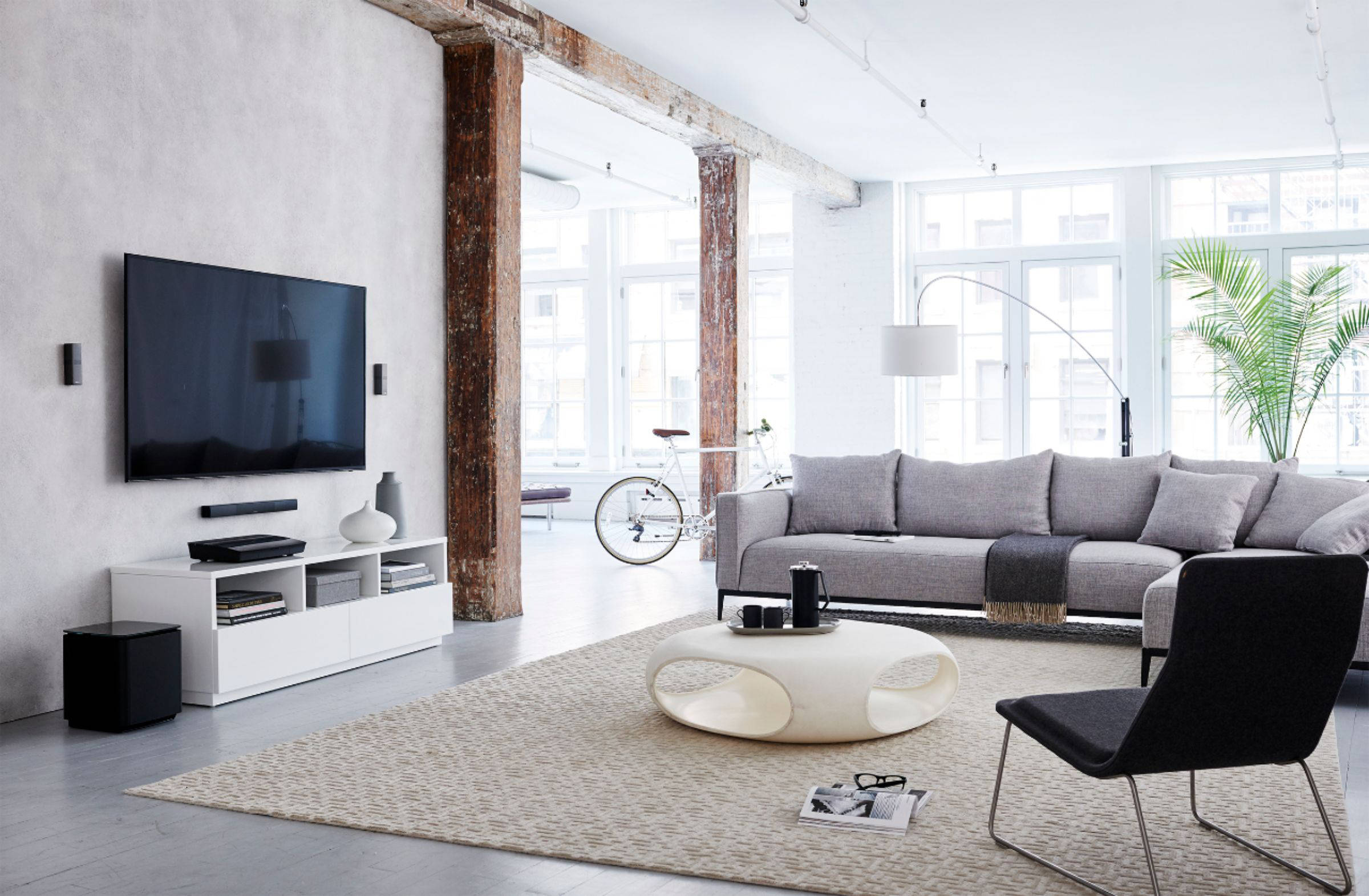
If you already have one of the new 4K, OLED, QLED, or Mini-LED TVs the best way to take your home theatre’s audio experience to the next level is with a Home theatre system. A home theatre sound system adds power and clarity to your TV’s speaker system. When you synchronize the video on your screen with room-filling sound, every sporting event, blockbuster movie, or favourite TV series will feel more immersive.
How do you choose the best home theatre system for your home? It can be a bit challenging to narrow down your options, but it’s a fun challenge because there are so many amazing brands and options to choose from. Here is what you’ll need to consider to quickly find the best home theatre system within your budget.
Home Theatre System Buying Guide Quick Reference Handout
Table of Contents
- What makes up a home theatre system?
- Building your home theatre system
- What to consider before choosing a home theatre system?
- Features on home theatre systems
What makes up a home theatre system?
A home theatre system is a set of audio components you connect together to make a home theatre or surround sound setup. The main device in a home theatre setup is your TV or projector. You add a receiver or a sound bar to your TV and pair it to external speakers and a subwoofer. A traditional surround sound home theatre system has 5.1 or 7.1 channels and includes one subwoofer and five or seven speakers including a center speaker, left speaker, right speaker, and two or four-tower, bookshelf, or ceiling speakers.
Building your home theatre system
Now that you know what to consider before choosing components, here is a step-by-step guide to building the best home theatre system for your home.
1. Decide how many channels you need
The first step in choosing the components to make up your home theatre system is to decide how many channels you’ll need. The number of channels you choose depends on how many speakers you would like to connect with. That choice may be determined by how large your room is.
Receiver-based home theatre systems are available with a variety of channels. The most common channels are 5.1, 7.1, and 9.1. The first number is the number of speakers in the system, and the second number is the number of subwoofers.
2. Wired vs Wireless speakers
The decision to have cords and cables vs a completely wire-free experience is usually an easy one. Your main issue will be whether or not it’s difficult to place or hide the cables connected to your home theatre.
Wireless speaker systems
Some people opt for wireless speaker systems because the installation is very simple and clean. Having a wireless system also allows you to easily move the speakers into different positions or use them elsewhere in your home, so if you’d like to use them on your patio you can pick them up and move them there.
Just keep in mind that a speaker is “wireless” when it doesn’t need wires to connect to your receiver; they still require a power plug as most are not battery-powered. The benefit is that you won’t have to connect several feet of cord to the receiver so it gives you more flexibility. Another thing to keep in mind when choosing wireless speakers is that there are only a few that will work well in a balanced “surround sound” application. Sonos and Bose are a few brands that produce wireless speaker systems.
Wired speaker systems
There are some advantages of a wired speaker system too. A wired speaker system usually has better sound quality because it’s connected directly to the receiver and it’s not limited to bandwidth. You’ll also have a wider variety of speakers to choose from and you’re more likely to find powerful and clear-sounding speakers that really suit your taste. You can learn more about these advantages on Best Buy’s Multi-room Audio Buying Guide.
3. Choose a receiver home theatre system or sound bar
The latest TVs and projectors have spectacular picture quality, but to get the best audio from your display, you’ll need to choose a receiver or a sound bar. All of the components you connect to your receiver or sound bar will be controlled by that device.

If you’d like a receiver-based home theatre system
There are a few ways to choose a receiver or receiver home theatre system for your home theatre.
- You can choose a receiver-based home theatre system with speakers that you can unbox, setup, and enjoy.
- A home theatre in a box with a receiver includes several speakers that connect together so your setup process will be plug-and-play with most TVs and projectors.
- If you’d like to customize your set up by choosing an individual receiver with the power and features you’d like, you can choose from a variety of 3,5,7,9, or 11-channel receivers.
If you’d like a sound bar home theatre system
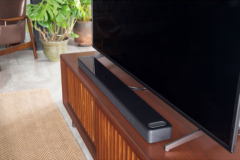 A sound bar is a long, thin speaker that connects to your TV or projector. Sound bars are popular because you can just plug them in and they will enhance your TV’s audio.
A sound bar is a long, thin speaker that connects to your TV or projector. Sound bars are popular because you can just plug them in and they will enhance your TV’s audio.
- You can choose from 2, 3, 5, 7, or 9-channel sound bars that will pair with add-on speakers.
- When you choose a sound bar you don’t need to add a receiver to your setup, and some of the latest sound bars offer Dolby Atmos or DTS:X audio so they can create the feeling of surround sound without external speakers.
If you’d rather not fill your room with individual speakers and you want a quick and easy way to update your sound profile, you may want to choose just a sound bar over a full surround sound system. Sound bars can be wireless, some have connections for several devices including gaming consoles, and they can be controlled via remote, Wi-Fi, Bluetooth, or voice.
4. Home theatre system vs individual components
A home theatre system or home theatre in a box is a simple setup because the speakers are designed to use the specific channel they will support. Your front left and right speakers will be designed to have the biggest impact as most sound comes from them, your centre speakers will be ready to push out dialogue, and your rear speakers will enhance your audio. The subwoofer will add deep bass beats and highlight sound effects.
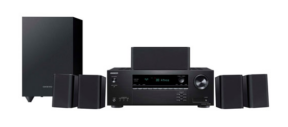
There are pros and cons to choosing a home theatre system vs individual components. The home theatre systems are available for receivers and sound bars.
- Pro – A home theatre system makes setting up an immersive home theatre easy. You just pick which system meets your needs and you’re set.
- Con – With a home theatre system, everything comes the way it is as a kit. If you have your heart set on a receiver made by a certain brand, you won’t be able to choose the receiver you want to buy individually.
On the other hand, it’s not that hard to buy pieces of your home theatre individually because you just mainly need to select the receiver and the speakers.
- Pro – Speakers are usually based on personal preference, so you can choose what sounds good to you.
- Pro – To choose your components, you just need to make sure the power output of the receiver you pick matches the capacity of the speakers.
- Con – It takes a bit more time to choose your home theatre components individually than it would take to just pick a home theatre system.
5. Choose your speakers
If you choose a home theatre system with a sound bar or receiver and speakers, you won’t have to choose additional speakers unless you want to add them to your system. If you’d like to choose your own speakers, you have a lot of options.
- Bookshelf speakers are small and fit neatly on a shelf or entertainment unit and can provide left and right-channel sound.
- Tower speakers are tall and thin, and they stand on their own beside your TV. They can also provide right and left-channel sound or can be used as rear speakers.
- Center channel speakers sit directly under your TV. This type of speaker is used to provide dialogue in a surround sound setup. If you have a sound bar your sound bar will provide the center channel.
- Ceiling or wall speakers are a must in a Dolby Atmos or DTS:X system. They add height to your audio so the sound will feel as though it is projecting from the ceiling to the floor.
- Subwoofers are one of the most important speakers in any home theatre setup. They offer deep bass sounds and amplify sound effects for the most immersive movie experience possible.
The most important factor when choosing speakers is to make sure they match the power output of the receiver you choose. Sound quality is also a big factor, and if you can’t head into a store to listen before you buy, you’ll want to take a good look at the overall ratings of each and decide on different features.
Another consideration when choosing speakers is brand. You may choose a set of speakers from big brands including Polk Audio, Bose, Sonos, Energy, Klipsch, JBL, Definitive Technology, Sony, Samsung, and Martin Logan.
6. Decide on placement for surround sound speakers
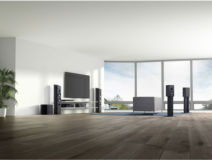
The most common choice for surround sound system in small to mid-size rooms has 5.1 channels, with five speakers and a subwoofer. Larger rooms do best with 7.1 or 9.1 or 9.2 systems, with nine speakers and two subwoofers.
- Example of nine-speaker placement
To place nine speakers around your room, you’ll usually place 5 in the front or around the TV with 2 to the left, 2 to the right, and 1 in the centre. The remaining speakers will be placed 2 on the side of the room and 2 at the rear of the room. The subwoofer can be placed to the side of the TV, but you’ll find some homes also place it behind or to the side of their couch.
- Example placement of Dolby Atmos surround system
If you choose a Dolby Atmos surround system it may be labelled as 5.1.2, 6.1, 7.1.4, or 9.1.4. The extra digit represents ceiling speakers, so a 7.1.4 Dolby atmos system has 7 floor level speakers, 1 subwoofer, and 4 ceiling speakers. An example of placement for the Dolby Atmos system has speakers placed 2 to the left, 2 to the right, and 1 in the centre. Two ceiling speakers are mounted above the TV area, one to the left and one to the right. The subwoofer can be placed on the side of the TV.
A Dolby Atmos system will give you the most immersive sound experience available, and you can find Dolby Atmos technology in both home theatre surround sound systems as well as individual speakers. The sound will feel as though it’s coming at you from every direction. You can take a look at the home speaker buying guide for more on how Dolby Atmos is built into home theatre speakers.
When choosing your setup, always keep in mind that the basic idea of a home theatre system is that the more speakers you have, the better your sound quality will be. The better the sound quality, the more you’ll enjoy movies and music at home.
7. Home theatre system accessories
You can’t enjoy your home theatre system without power or a way to control it, so here are a few home theatre accessories you may want to add.
- Universal remote control
Your receiver or sound bar will have a remote control or app you can use to connect and control your audio and video devices. Some remote controls will not pair with all components so you may want to choose a universal remote control for your home theatre setup.
- HDMI cables and speaker wires
While most home theatre systems will offer wireless speaker connections, some do connect via speaker wire. You can read more about the pros and cons of a wireless vs wired home theatre setup in this article.
While your speaker connections will depend on what type you choose, to add devices like gaming consoles, media streaming devices, your TV, or your projector, you’ll need HDMI cables. A good rule of thumb when choosing HDMI cables is to buy the best cables for your home theatre setup. For example, if you have a 4K receiver and TV, choose a cable that can support 4K.
- Power protection and plugs
Your home theatre setup should look seamless, and one of the best ways to manage power plugs is a power bar. There are different types you can choose, but the best for a home theatre is one with enough ports for a TV or projector, sound bar or receiver, and all of your speakers. You’ll also want to look for one with surge protection in case of power surges.
What to consider before choosing a home theatre system?
1. Consider room size and setup
Your first step in setting up a home theatre system is to take a good look at the room your TV is in. Whether that be a living room, basement, or rec room, your home theatre’s size will have the biggest impact on the type of surround sound system you’ll choose.
- If your room is fairly small
You may only need a few speakers and a single subwoofer. With a small space, you may also opt just for wall-mounted speakers instead of larger tower speakers.
- If you have a larger room
You can really expand your sound system in a larger room. You can choose a powerful receiver or sound bar and add bigger speakers with more wattage or features to fill the room with sound.
- If your room is mid-size
If you feel your home theatre room size is somewhere in the middle between big and small, a good way to choose the best system is to decide based on the size of your TV. If your TV is 65″ or larger, you can choose a system with more power and extra speakers. If your TV is smaller, and if you have a small room to fill with sound, you can choose smaller speakers and less power.
2. Movies or music? Which is your favourite?
When you add speakers, a subwoofer, and a receiver to set up a home theatre system, everything you watch on your TV and everything you listen to will instantly become more immersive.
- If you’re mostly interested in listening to music you may want to choose a two-channel stereo receiver. Your home theatre receiver will perform the same function by using two channels to distribute your favourite music to your speakers. The front left and right speakers are the most important, and the accompanying subwoofer will add clarity and depth to your playlists.
- If you’re mainly interested in enjoying movies, you’ll want the subwoofer you choose to be able to achieve deep-bass effects. You’ll also want to select a centre channel speaker that’s able to distribute dialogue in a way that’s crisp, clear, and matches your other speakers perfectly.
Features to look for on home theatre systems
Once you’ve narrowed down your main selections and you’ve decided on the best home theatre system for you, you’ll want to take a look at a few individual features that can make your home theatre even better.
1. Number and type of HDMI connections
Most receivers have multiple HDMI, optical, and other connections so you can connect everything from your TV to gaming consoles, streaming box, or cable boxes. You can use your receiver to easily switch between the various applications, so be sure to choose one that can handle all of your devices. You can choose a receiver with 4 up to 10 HDMI connections.
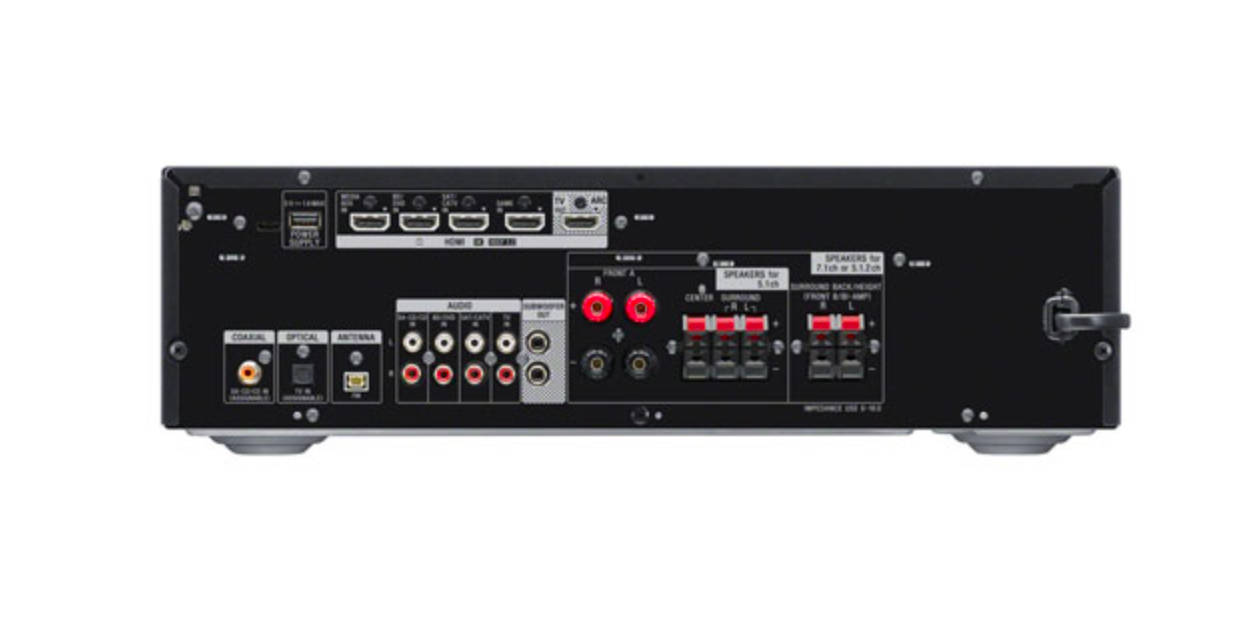
2. Surround sound technology
If you’d like Dolby Atmos or DTS:X, you can choose a receiver with that technology built-in. Dolby Atmos supported home theatre receivers use 3D object based sound. Sound objects are placed in a timeline to create the feeling of movement across your speakers. For example, if a train is moving across your screen, Dolby Atmos will track the soundtrack so it sounds as though the train is rolling past you from left to right or right to left.
3. Phono input
One important feature you might wish to have on your receiver is a dedicated “Phono” input. This input offers better sound quality than computer chips or integrated circuits and allows for improved dynamics, depth of field, and sound detail. Even if you don’t have a phonograph to connect to your receiver, it’s a good feature for other electronics.
4. Enabled pass-through
Depending on what you’re connecting to the receiver, you may wish to choose a pass-through for 3D, HDMI, 4K Ultra HD, or 8K Ultra HD. This means that your receiver will support 3D, 4K, or 8K resolution.

5. Apps and connectivity
Do you want your receiver to be able to run apps like Spotify or use Google Cast and Apple Airplay? You can find many choices with these options built in, and many will also connect to your favourite Internet radio stations so you can stream the radio to your speakers.
There are also receivers that are controlled via a compatible app, so you can adjust your settings or switch between content right on your phone.
6. Smart features
If you rely on your voice assistant to control devices in your smart home, you’ll want to take a look at receivers with voice control built-in. You can find receivers with Google Assistant, Alexa, and Siri compatibility.
7. Automatic speaker setting calibration
There are a few additional home theatre features you may find useful. Some speakers will have automatic speaker setting calibration so it’s easy to set up and perfect the sound of your speakers. You can also choose a receiver and speakers with multi-room capability so you can use the A/V receiver to transmit sound to another room in your house.
Take the next step
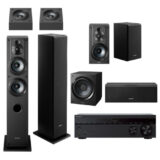 A home theatre system lets you really enjoy everything you watch and listen to. From music to movies to TV and your favourite playlists, you’ll love how a home theatre system makes everything more immersive. Shop Best Buy for your next Home Theatre system.
A home theatre system lets you really enjoy everything you watch and listen to. From music to movies to TV and your favourite playlists, you’ll love how a home theatre system makes everything more immersive. Shop Best Buy for your next Home Theatre system.

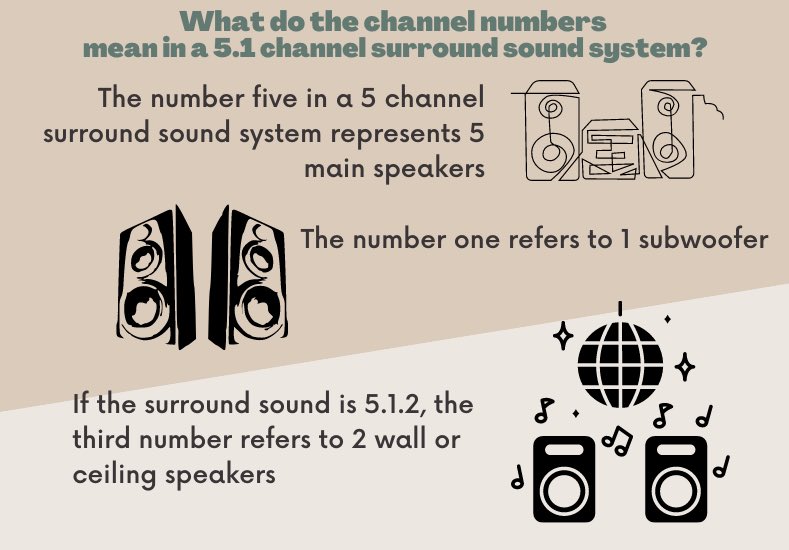





Very useful
Thank you for your guide. I and my husband are planning to buy a home cinema screen. It’s a great help. Thank you!
Hi, I’m glad it was useful for you! That is always our goal with buying guides 🙂
I’ve been looking for a good home theater system, and I think that being able to get some tips would be nice. I’m glad you talked about how you want to get the right speakers for your home theater system, which I think would be great. I’m going to have to look for a home theater system, and see what we can find!
Comments are closed.